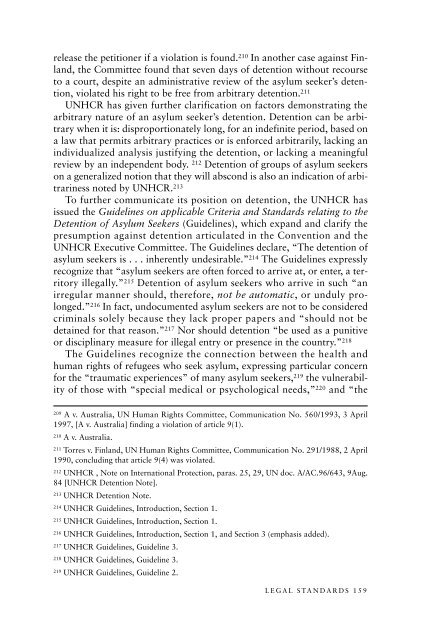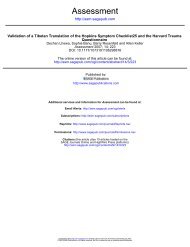elease the petitioner if a violation is found. 210 In another case against Finland,the Committee found that seven days <strong>of</strong> detention without recourse<strong>to</strong> a court, despite an administrative review <strong>of</strong> the asylum seeker’s detention,violated his right <strong>to</strong> be free from arbitrary detention. 211UNHCR has given further clarification on fac<strong>to</strong>rs demonstrating thearbitrary nature <strong>of</strong> an asylum seeker’s detention. Detention can be arbitrarywhen it is: disproportionately long, <strong>for</strong> an indefinite period, based ona law that permits arbitrary practices or is en<strong>for</strong>ced arbitrarily, lacking anindividualized analysis justifying the detention, or lacking a meaningfulreview by an independent body. 212 Detention <strong>of</strong> groups <strong>of</strong> asylum seekerson a generalized notion that they will abscond is also an indication <strong>of</strong> arbitrarinessnoted by UNHCR. 213To further communicate its position on detention, the UNHCR hasissued the Guidelines on applicable Criteria and Standards relating <strong>to</strong> theDetention <strong>of</strong> Asylum Seekers (Guidelines), which expand and clarify thepresumption against detention articulated in the Convention and theUNHCR Executive Committee. The Guidelines declare, “The detention <strong>of</strong>asylum seekers is . . . inherently undesirable.” 214 The Guidelines expresslyrecognize that “asylum seekers are <strong>of</strong>ten <strong>for</strong>ced <strong>to</strong> arrive at, or enter, a terri<strong>to</strong>ryillegally.” 215 Detention <strong>of</strong> asylum seekers who arrive in such “anirregular manner should, there<strong>for</strong>e, not be au<strong>to</strong>matic, or unduly prolonged.”216 In fact, undocumented asylum seekers are not <strong>to</strong> be consideredcriminals solely because they lack proper papers and “should not bedetained <strong>for</strong> that reason.” 217 Nor should detention “be used as a punitiveor disciplinary measure <strong>for</strong> illegal entry or presence in the country.” 218The Guidelines recognize the connection between the health andhuman rights <strong>of</strong> refugees who seek asylum, expressing particular concern<strong>for</strong> the “traumatic experiences” <strong>of</strong> many asylum seekers, 219 the vulnerability<strong>of</strong> those with “special medical or psychological needs,” 220 and “the209A v. Australia, UN Human Rights Committee, Communication No. 560/1993, 3 April1997, [A v. Australia] finding a violation <strong>of</strong> article 9(1).210A v. Australia.211Torres v. Finland, UN Human Rights Committee, Communication No. 291/1988, 2 April1990, concluding that article 9(4) was violated.212UNHCR , Note on International Protection, paras. 25, 29, UN doc. A/AC.96/643, 9Aug.84 [UNHCR Detention Note].213UNHCR Detention Note.214UNHCR Guidelines, Introduction, Section 1.215UNHCR Guidelines, Introduction, Section 1.216UNHCR Guidelines, Introduction, Section 1, and Section 3 (emphasis added).217UNHCR Guidelines, Guideline 3.218UNHCR Guidelines, Guideline 3.219UNHCR Guidelines, Guideline 2.LEGAL STANDARDS 159
very negative effects <strong>of</strong> detention on the psychological well-being <strong>of</strong> thosedetained.” 221 These fac<strong>to</strong>rs play a key role in the presumption againstdetention and should be “taken in<strong>to</strong> account in determining any restrictionson freedom <strong>of</strong> movement based on illegal entry.” 222There<strong>for</strong>e “active consideration <strong>of</strong> possible alternatives should precedeany order <strong>to</strong> detain . . . [t]orture or trauma victims [or p]ersons with amental or physical disability.” 223 In an ef<strong>for</strong>t <strong>to</strong> give <strong>for</strong>ce <strong>to</strong> the presumptionagainst detention <strong>of</strong> asylum seekers, the Guidelines urge the use <strong>of</strong>several alternatives, including but not limited <strong>to</strong>, various mechanisms <strong>for</strong>“moni<strong>to</strong>ring” the whereabouts <strong>of</strong> released applicants; provision <strong>of</strong> “guaran<strong>to</strong>rs,”or sponsors, who would ensure the applicant’s appearance a<strong>to</strong>fficial meetings and hearings; release on bail; and residence at “open centers”created specifically <strong>for</strong> the supervision <strong>of</strong> released asylum seekers. 224In addition, when detained, an asylum seeker should receive an individualizeddetermination <strong>of</strong> the reasons <strong>for</strong> the detention and au<strong>to</strong>matic periodicreview be<strong>for</strong>e an independent judicial or administrative body. 225The Guidelines’ prohibition against routine detention applies <strong>to</strong> thosewho already have asylum (or refugee status) and also <strong>to</strong> those seeking asylum.It applies “<strong>to</strong> asylum seekers pending determination <strong>of</strong> their status,as recognition <strong>of</strong> refugee status does not make an individual a refugee butdeclares him <strong>to</strong> be one.” 226According <strong>to</strong> the Guidelines, detention is not permissible as a deterrentand has raised concern among international experts and authorities. 227 Itis prohibited “To deter future asylum seekers, or <strong>to</strong> dissuade those whohave commenced their claims from pursuing them,” by detaining them. 228“UNHCR has repeatedly stated that asylum seekers should not bedetained <strong>for</strong> purposes <strong>of</strong> deterrence,” the agency said in 2002 in regard <strong>to</strong>the US practice <strong>of</strong> detaining Haitian asylum seekers. 229220UNHCR Guidelines, Introduction, Section 1.221UNHCR Guidelines, Guideline 7.222UNHCR Guidelines, Guideline 7.223UNHCR Guidelines, Guideline 7.224UNHCR Guidelines, Guideline 4.225UNHCR Guidelines, Guideline 5.226UNHCR Guidelines, Guideline 5.227UN Sub-Commission on Human Rights resolution 2000/21, Detention <strong>of</strong> Asylum Seekers,18 Aug. 2000, at www.unhchr.ch/huridoca/huridoca.n…ocument&Highlight=2,guidelines,on,seekers,accessed on 12 Feb. 02 [HR Sub-Commission on Detention <strong>of</strong> AsylumSeekers]; Global Consultations on International Protection, Geneva Expert Round Table, 8-9 Nov. 2001, Summary Conclusions on Article 31 <strong>of</strong> the 1951 Convention relating <strong>to</strong> theStatus <strong>of</strong> Refugees—Revised, para. 11(c).228UNHCR Guideline No.3.229UNHCR Advisory Opinion.160 FROM PERSECUTION TO PRISON
- Page 2 and 3:
From Persecution to Prison:The Heal
- Page 4 and 5:
CONTENTSAcknowledgements . . . . .
- Page 6:
The Bellevue/NYU Program for Surviv
- Page 9 and 10:
don, Miranda Ip, and Meriam Alrashi
- Page 11 and 12:
Significant symptoms of depression
- Page 13 and 14:
Detained asylum seekers participati
- Page 15 and 16:
persecution, yet most emphasized ho
- Page 17 and 18:
In many facilities, the response to
- Page 19 and 20:
years in detention, she finally got
- Page 21 and 22:
abuse For example, while being take
- Page 23 and 24:
They didn’t let me use the phone
- Page 25 and 26:
intensely personal events they had
- Page 27 and 28:
Limitations of this study include t
- Page 29 and 30:
Non-governmental organizations serv
- Page 31 and 32:
22 FROM PERSECUTION TO PRISON
- Page 33 and 34:
the late 1990s ranging from 10 to 7
- Page 35 and 36:
Historical BackgroundFor most of th
- Page 37 and 38:
international standards with the 19
- Page 39 and 40:
apply for asylum make up the majori
- Page 41 and 42:
tion judge. 57 Yet in many parts of
- Page 43 and 44:
York and Newark, New Jersey has had
- Page 45 and 46:
trict began denying parole to them
- Page 47 and 48:
Correctional Facility in 2000. “[
- Page 49 and 50:
men of which 750 were detained on i
- Page 51 and 52:
from that same country from seeking
- Page 53 and 54:
Detention Facilities in this StudyF
- Page 55 and 56:
high reliability in numerous langua
- Page 57 and 58:
48 FROM PERSECUTION TO PRISON
- Page 59 and 60:
York County Prison in York Pennsylv
- Page 61 and 62:
TABLE 2:Demographic Characteristics
- Page 63 and 64:
TABLE 4:Prevalence of Pre-Migration
- Page 65 and 66:
on a part time basis, researchers w
- Page 67 and 68:
Case #1(DK): “Loneliness and Fear
- Page 69 and 70:
TABLE 6:Hopkins Symptom Checklist-2
- Page 71 and 72:
TABLE 8:Harvard Trauma Questionnair
- Page 73 and 74:
think such services were available.
- Page 75 and 76:
When I am talking to you now it is
- Page 77 and 78:
After being granted asylum and rele
- Page 79 and 80:
“Being here is like going through
- Page 81 and 82:
In my country even though I became
- Page 83 and 84:
how long they were there - six mont
- Page 85 and 86:
Thoughts of SuicideSeveral asylum s
- Page 87 and 88:
here?’ I told the doctor, they br
- Page 89 and 90:
Another subject reported a positive
- Page 91 and 92:
substantial distance from their att
- Page 93 and 94:
eported that her experience in dete
- Page 95 and 96:
86 FROM PERSECUTION TO PRISON
- Page 97 and 98:
e somatic manifestations of the psy
- Page 99 and 100:
Case #2 (JG): “Health Care in Cha
- Page 101 and 102:
TABLE 11:Detainee Perceptions of He
- Page 103 and 104:
TABLE 13:Availability and Quality o
- Page 105 and 106:
detainees, or because they did not
- Page 107 and 108:
Difficulty Obtaining Specialized Ca
- Page 109 and 110:
Another detained asylum seeker repo
- Page 111 and 112:
One detainee who speaks French and
- Page 113 and 114:
104 FROM PERSECUTION TO PRISON
- Page 115 and 116:
Detention Facilities in this StudyS
- Page 117 and 118: even though many reported having ex
- Page 119 and 120: CASE #3 (HN): “SOLITARY CONFINEME
- Page 121 and 122: Here, I’m scared. In [the detenti
- Page 123 and 124: emote control and watch what he wan
- Page 125 and 126: Whenever someone misbehaves, they t
- Page 127 and 128: This subject was himself threatened
- Page 129 and 130: One detainee reported several incid
- Page 131 and 132: Some Process Exists to Respond to R
- Page 133 and 134: There were no witnesses other than
- Page 135 and 136: tion. An INS officer said they put
- Page 137 and 138: There is an Anglican minister who c
- Page 139 and 140: The dentists didn’t explain anyth
- Page 141 and 142: tion between dental age and chronol
- Page 143 and 144: Case #4 (LK): “Fifteen-Year-Old G
- Page 145 and 146: 136 FROM PERSECUTION TO PRISON
- Page 147 and 148: TABLE 16:Treatment/Abuses Reported
- Page 149 and 150: “There is no political asylum her
- Page 151 and 152: I was crying. I was so afraid with
- Page 153 and 154: save her life, but was not able to
- Page 155 and 156: Case #5 (CR): “Begging for Mercy
- Page 157 and 158: ehind and told me to sign. He physi
- Page 159 and 160: days and it is now 2 years and four
- Page 161 and 162: viewers asked for additional inform
- Page 163 and 164: y study participants. In evaluating
- Page 165 and 166: trast, under US law, detention of s
- Page 167: nation for an asylum determination
- Page 171 and 172: authority to grant asylum and with
- Page 173 and 174: absconding.” 250 Since the passag
- Page 175 and 176: said “[F]reedom from imprisonment
- Page 177 and 178: Standards relevant to this study ar
- Page 179 and 180: “detained person” generally as
- Page 181 and 182: which they are charged and a fair h
- Page 183 and 184: esponse to substantial public press
- Page 185 and 186: specified procedures, provided they
- Page 187 and 188: PunishmentThe Detention Standard on
- Page 189 and 190: any time the detainee complains.”
- Page 191 and 192: 182 FROM PERSECUTION TO PRISON
- Page 193 and 194: while in detention, thus adding to
- Page 195 and 196: Establish a Uniform National Parole
- Page 197 and 198: that effect. These officers should
- Page 199 and 200: Besides their inaccuracy, these exa
- Page 201 and 202: friends so asylum seekers can maint
- Page 203 and 204: appropriate staffing of such groups
- Page 205 and 206: efugees and asylum seekers who win
- Page 207 and 208: 198 FROM PERSECUTION TO PRISON
- Page 209 and 210: of thorough documentation. However,
- Page 211 and 212: Human development is complex and di
- Page 213 and 214: 18. Country from which fleeing pers
- Page 215 and 216: 9. Being close to death.10. Forced
- Page 217 and 218: Complete for each health problem:5.
- Page 219 and 220:
Explain:(Interviewer: Write brief n
- Page 221 and 222:
2. Depression SymptomsA How much we
- Page 223 and 224:
B. You said that you have experienc
- Page 225 and 226:
Explain:13. How was your physical h
- Page 227 and 228:
Yes ...........1No............22. W
- Page 229 and 230:
Explain:20. At the time of your arr



